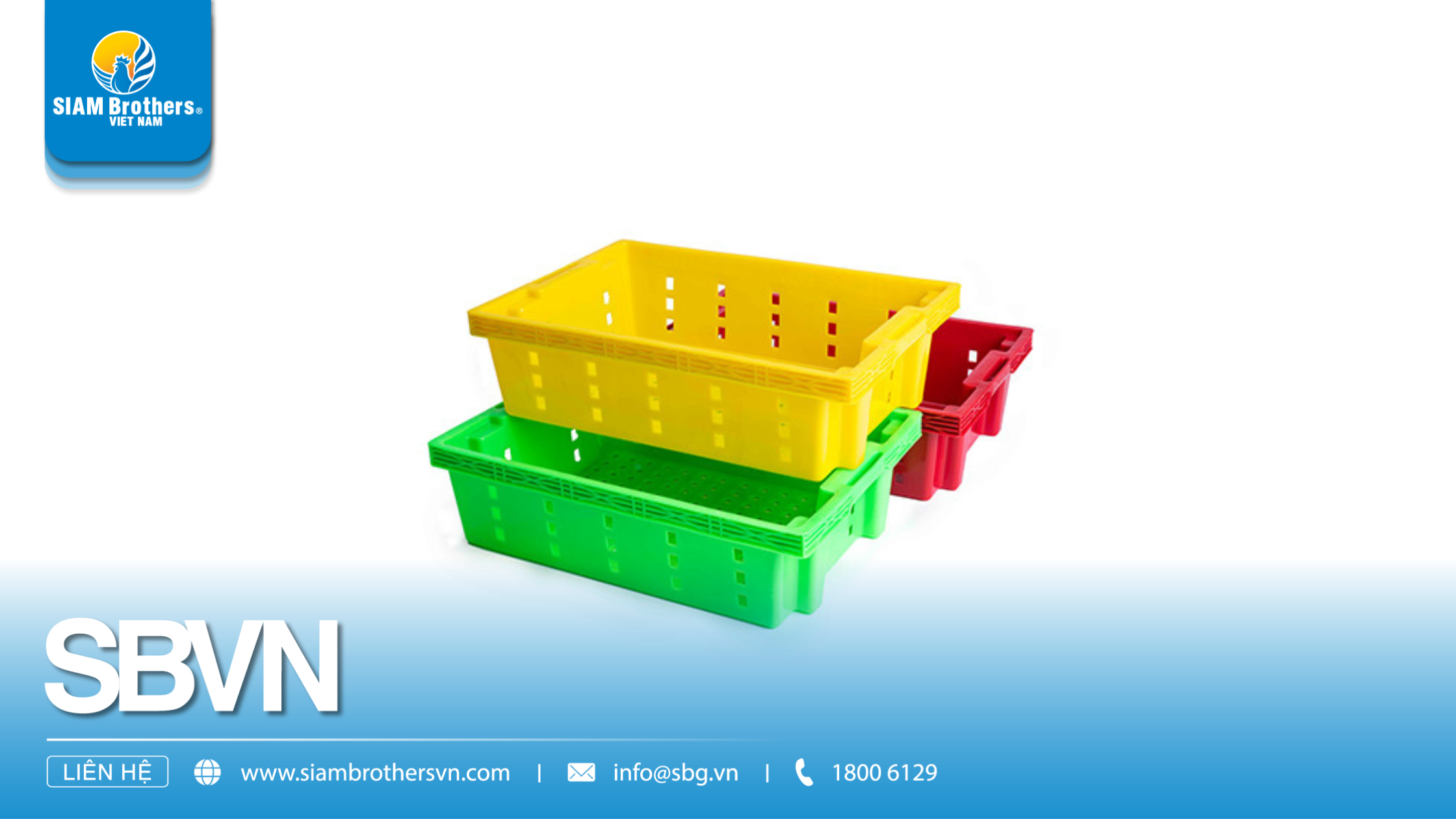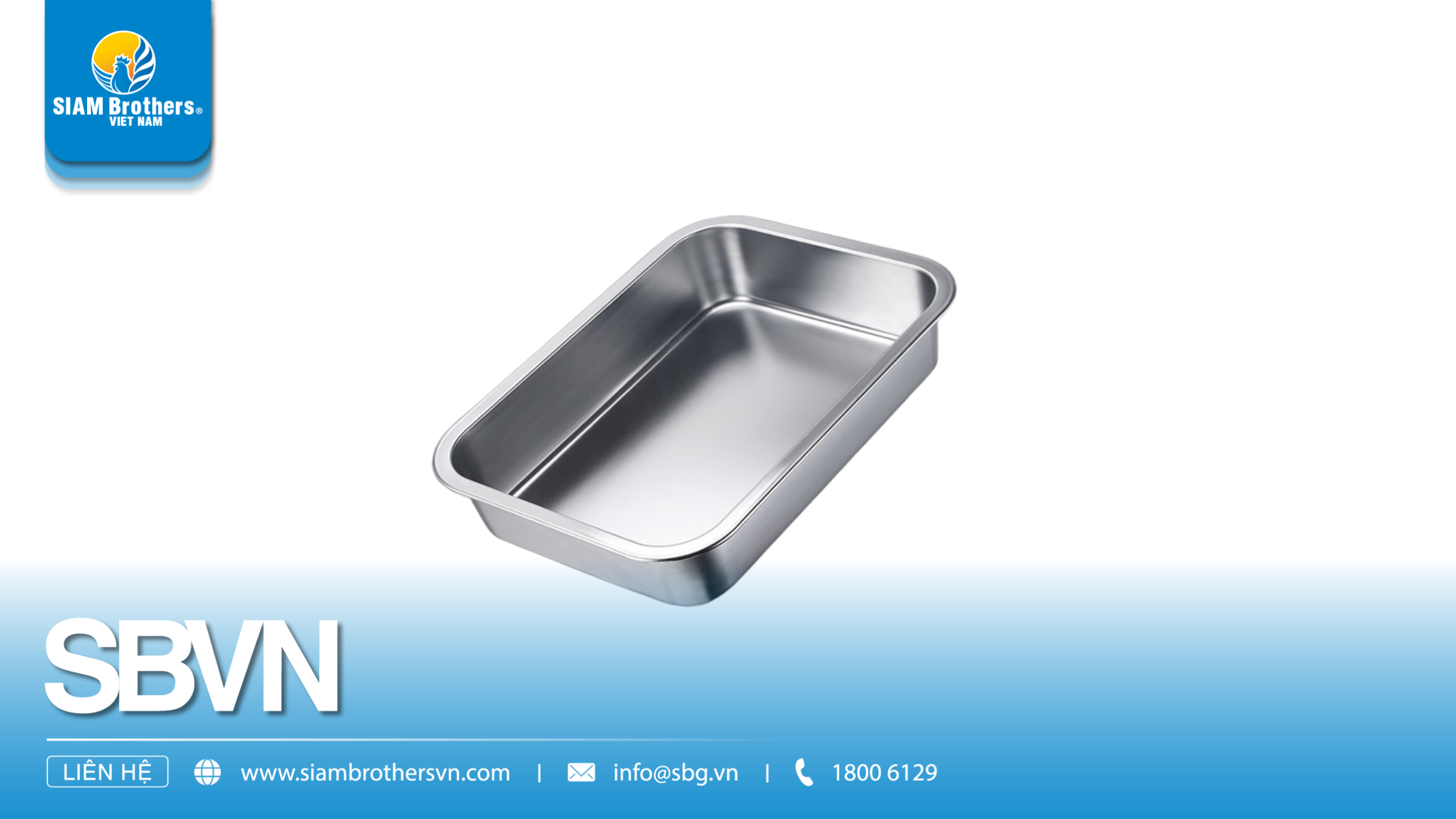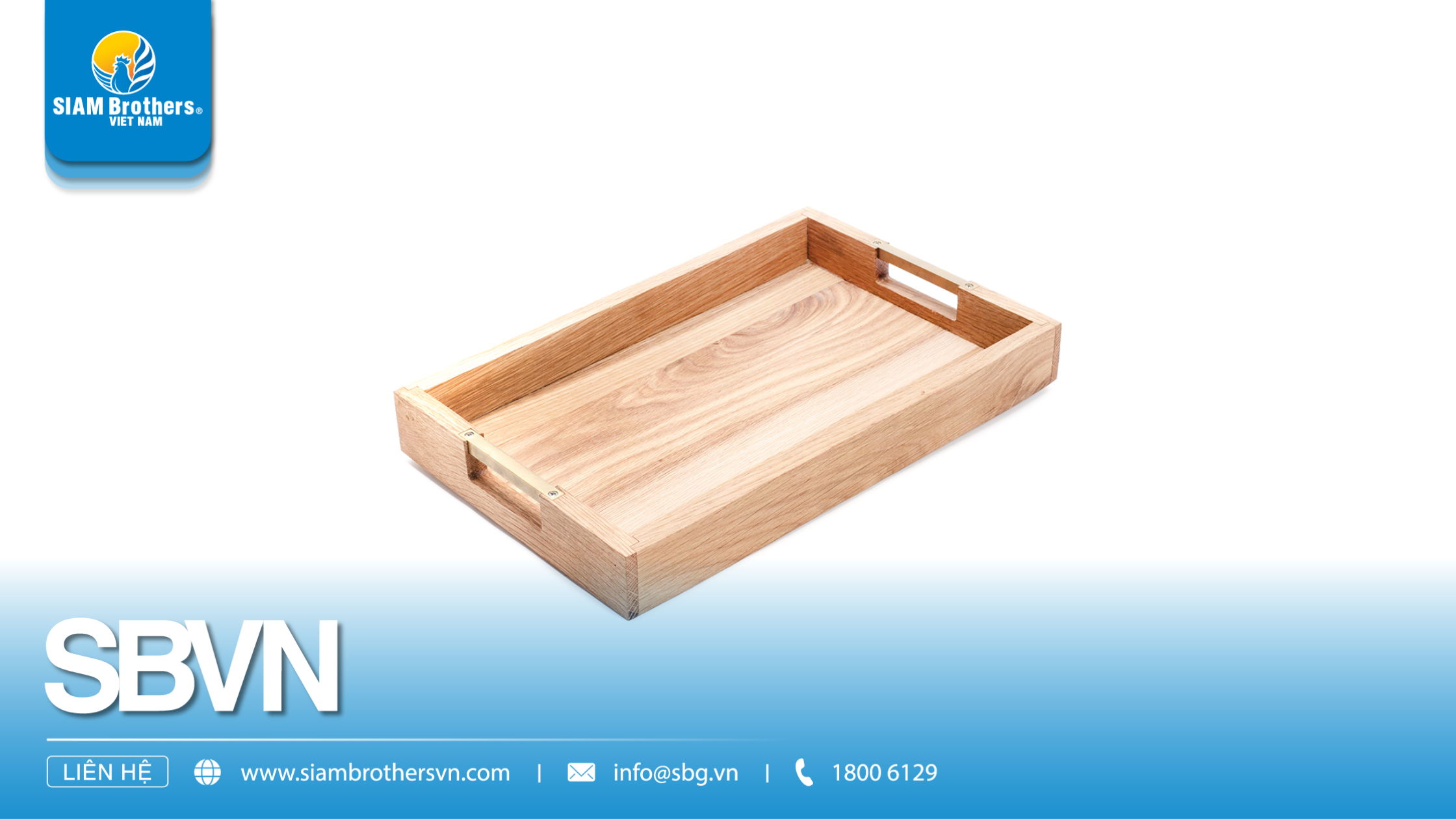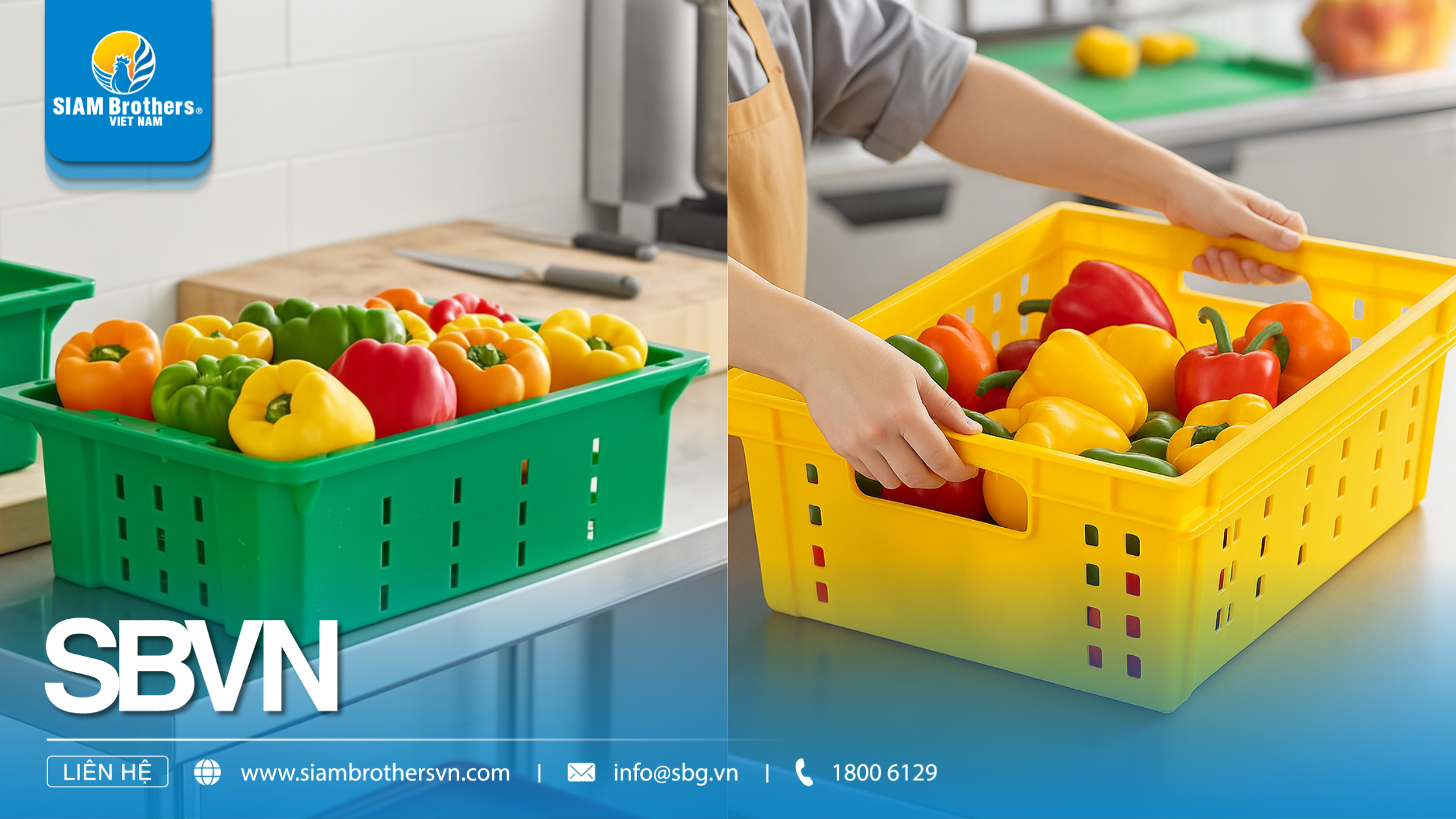Are you unsure whether to choose a plastic, stainless steel, or wooden vegetable storage tray? Each material offers its own advantages in terms of durability, aesthetics, and cost — but which one truly meets your practical needs for storing, transporting, or displaying fresh produce?
In this article, SIAM Brothers Vietnam will walk you through a comprehensive comparison of the most popular vegetable tray types, evaluating them based on key criteria such as durability, hygiene, eco-friendliness, and usability.
Especially if you're working in agriculture, vegetable distribution, or retail management, don’t miss our recommendations at the end — tailored to specific usage needs.
1. Growing Demand for Vegetable Trays – Why Choosing the Right Material Matters
1.1 Trays Must Meet Various Needs in Storage and Transportation
- Freshly harvested vegetables need to be stored in dry, well-ventilated conditions with minimal impact.
- A well-designed vegetable tray helps preserve freshness and reduce damage during handling.
- For farmers and cooperatives, plastic trays with effective drainage are often a key solution.
1.2 Ensuring Food Safety
- Vegetables are highly susceptible to contamination if exposed to unsafe materials.
- Choosing trays made from food-grade virgin plastic, stainless steel, or treated antibacterial wood helps minimize the risk of cross-contamination.

1.3 Optimizing Storage and Organization
- In warehouses or delivery trucks, vegetable trays that can be stacked securely and take up minimal space are a significant advantage.
- Features like ergonomic handles and non-slip edges help improve handling efficiency.
1.4 Cost Efficiency Over Time
- Using the right material reduces wear and tear, lowering replacement costs.
- For high-frequency users like farms or vegetable processing centers, a wise initial investment ensures better long-term cost savings.
1.5 Matching the Tray to Its Intended Use
- Each material has strengths: plastic for transportation, stainless steel for kitchens, and wood for retail display.
- Understanding your specific use case is key to choosing the most suitable vegetable tray.
2. Common Types of Vegetable Trays on the Market
2.1 Plastic Vegetable Trays – The Most Affordable and Versatile Solution
- Widely used thanks to their lightweight design, ease of cleaning, and budget-friendly price.
- Materials: HDPE or virgin PP plastic, safe for direct food contact.
Advantages:
- Waterproof and resistant to moisture or chemicals.
- Available in many designs: ventilated, stackable, with handles.
- Lightweight helps reduce transport costs.
Disadvantages:
- Cannot withstand high heat.
- Some recycled plastics may not be food-safe.
Best for: Farms, cooperatives, shipping units, and large-scale produce processing.

2.2 Stainless Steel Vegetable Trays – Durable and Hygienic, but Limited Use Cases
Ideal for environments requiring strict hygiene standards, like commercial kitchens or central kitchens.
Advantages:
- Sturdy, rust-resistant, and easy to clean.
- Doesn’t retain odors or absorb moisture.
Disadvantages:
- Higher cost than most trays.
- Heavier, less stackable, and not ideal for transport.
Best for: Restaurants, industrial kitchens, and clean food prep areas.

2.3 Wooden Vegetable Trays – High Aesthetic Value, Best for Displays
Common in organic stores, farmer’s markets, and retail setups due to their natural, professional look.
Advantages:
Enhances presentation in retail settings.
Disadvantages:
- Prone to mold or pests if not properly treated.
- Not suitable for transporting large quantities of fresh produce.
Best for: Mini-marts, fresh produce stores, and premium retail spaces.

3. Detailed Comparison Table of Vegetable Trays by Key Criteria
| Criteria |
Plastic Vegetable Tray |
Stainless Steel Vegetable Tray |
Wooden Vegetable Tray |
| Weight |
Light |
Heavy |
Medium |
| Durability & Load Capacity |
High |
Very high |
Medium |
| Ease of Cleaning & Sanitizing |
Easy to clean |
Very easy |
Hard to clean |
| Aesthetics |
Moderate |
Clean and glossy |
Rustic and eco-friendly |
| Reusability & Eco-friendliness |
Good – if made from virgin plastic |
Good – but resource-intensive to produce |
Good – biodegradable |
| Cost |
Low |
High |
Medium to high |
| Best Use Case |
Transport, storage, harvesting |
Kitchen, food processing |
Store displays |
4. Which Type of Vegetable Tray Should You Choose? Recommendations Based on Usage Needs
4.1 For Farms, Agricultural Cooperatives, and Produce Wholesalers
Recommended: Industrial HDPE plastic trays with drainage holes and side handles.
Why:
- Lightweight, convenient for harvesting and loading.
- Strong and stackable without deformation.
- Perforated design improves ventilation and prevents waterlogging.
4.2 For Logistics Providers and Agricultural Warehouses
Recommended: Rigid plastic trays with smooth, easy-to-clean surfaces.
Why:
- Stackable to optimize storage space.
- Water-resistant, helps maintain vegetable freshness during long-term storage.
- Durable for repeated reuse without warping.
4.3 For Supermarkets, Organic Food Stores, and Display Counters
Recommended: Combine wooden trays for display with plastic trays for storage and transport.
Why:
- Wooden trays enhance natural aesthetics and customer experience.
- Ideal for creating a fresh-from-the-farm visual appeal.
- Plastic trays used in the back ensure efficient logistics without affecting the display.
4.4 For Industrial Kitchens, Restaurants, and Food Processing Zones
Recommended: Food-grade stainless steel trays.
Why:
- Extremely durable, rust-proof, and hygienic.
- Odor-resistant and easy to sanitize.
- Suitable for professional environments requiring high cleanliness standards.
4.5 For Households Growing or Using Small Quantities of Vegetables
Recommended: Compact plastic trays with drainage holes or rustic wooden trays.
Why:
- Cost-effective and widely available.
- Easy to clean and doesn’t take up much space in kitchens, balconies, or gardens.
- Versatile use: rinsing, storing, or seedling propagation.

Whether you're harvesting on a farm, storing in a warehouse, or showcasing vegetables in a retail space – choosing the right vegetable tray is crucial to optimizing costs, preserving freshness, and improving operational efficiency.
Looking for durable, safe, and agriculture-friendly vegetable trays?
Contact SIAM Brothers Vietnam – a trusted manufacturer and supplier of high-quality industrial plastic trays, designed for harvesting, transporting, and preserving fresh produce.





